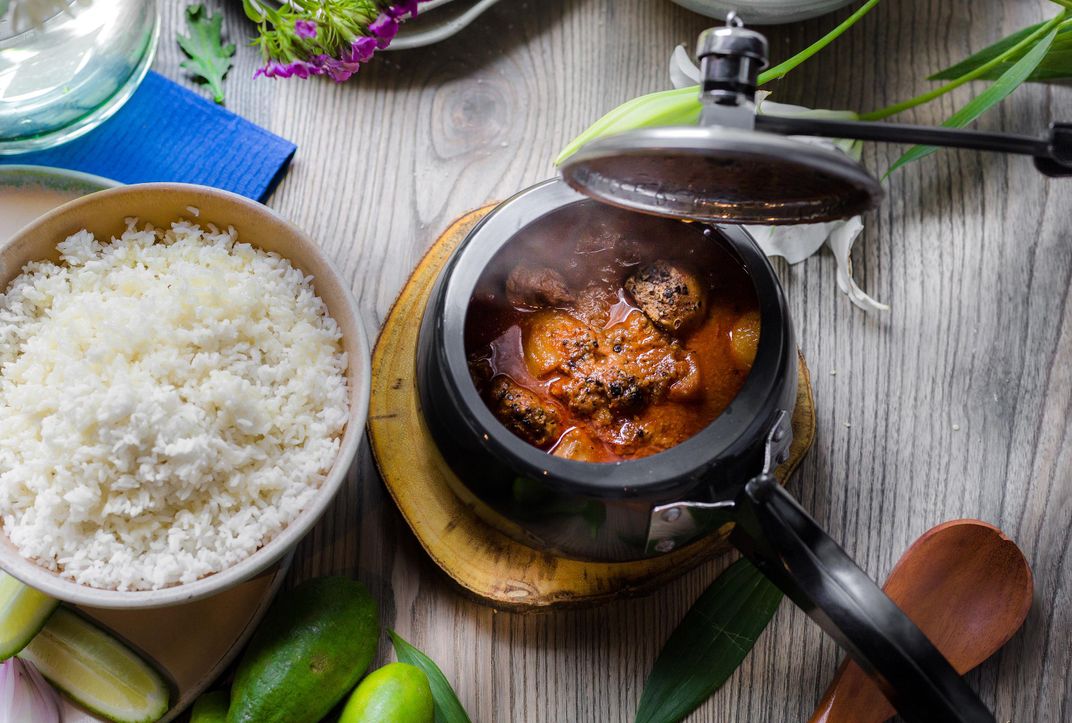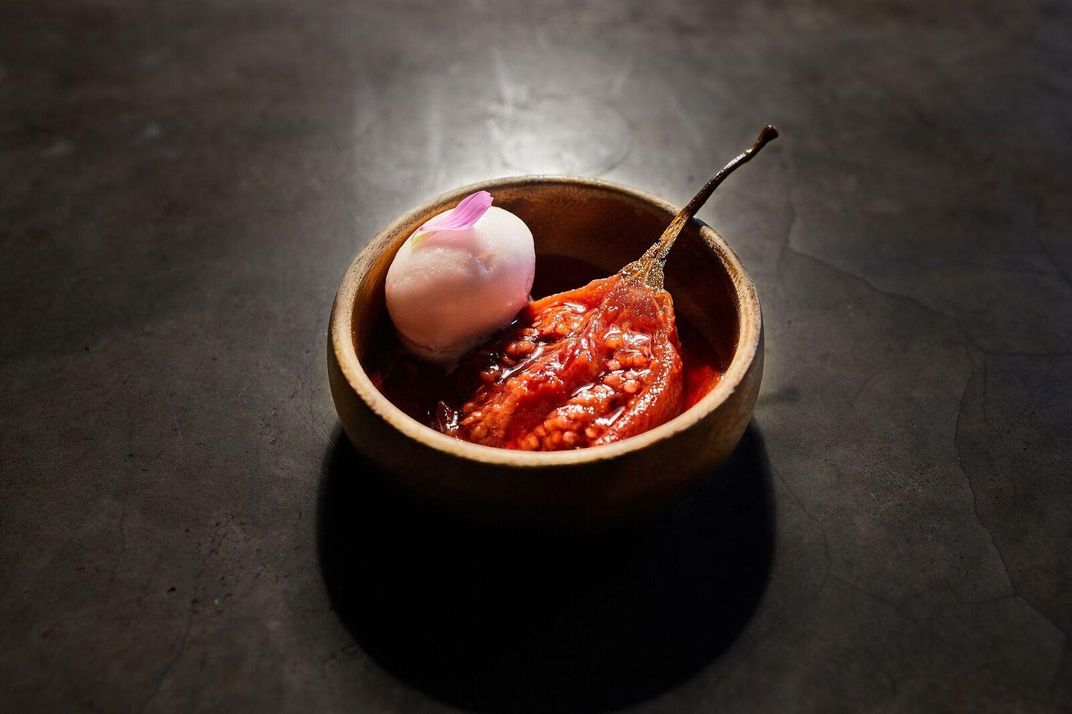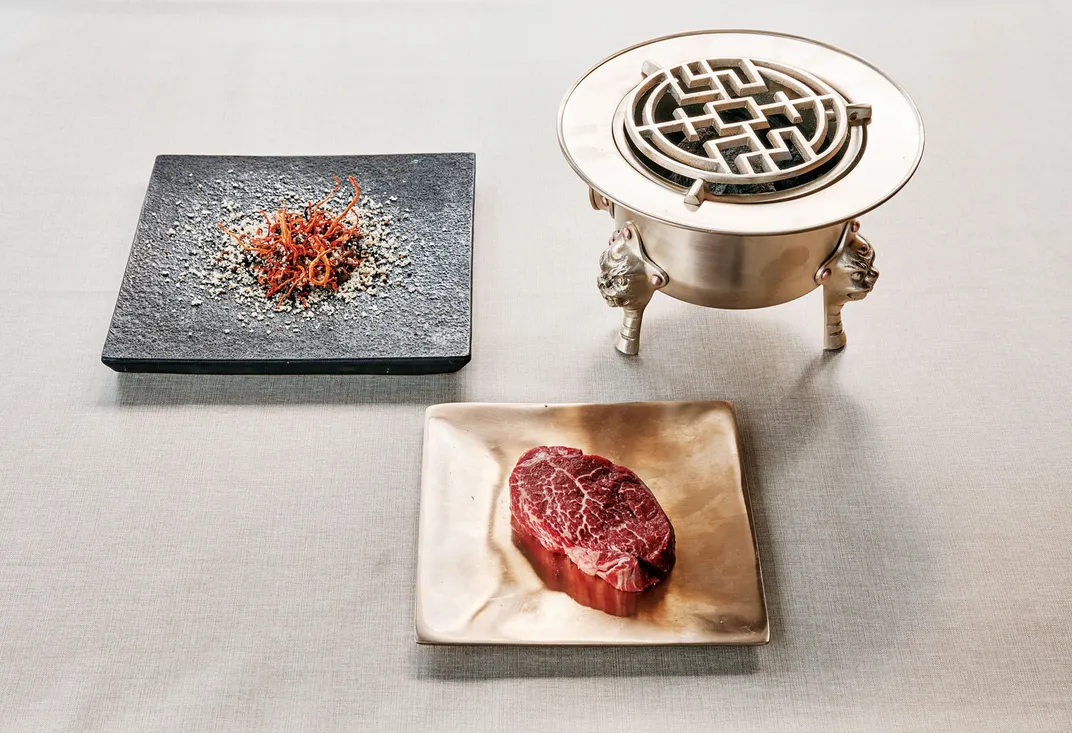Four Restaurants Bringing Traditional Dishes into Contemporary Cuisine
These chefs are putting modern spins on ancient recipes
/https://tf-cmsv2-smithsonianmag-media.s3.amazonaws.com/filer/eb/c1/ebc1c25c-4b40-43d0-8acf-ecdf48fa6b4a/trinifish_the_armenian_fish_performance.jpg)
Tucked away in the basement of a Yerevan apartment building, off downtown's bustling Tumanyan Street, The Club has been an informal gathering place for Armenia's post-Soviet-era writers, artists and intellectuals for well over a decade. Trend-setting types sit down to plates of fried chicken breast with fruit sauce and foil-stewed trout fillets at candle-lit wooden tables. The menu is proudly rooted in Armenian traditions, but sprinkled with twists that face decidedly into the future. “We had two goals [with The Club],” says Co-Founder and General Manager Andranik Grigoryan. “First, to offer what we best know and love—Armenian food—and then to give our dishes new life through innovative ingredients and culinary methods.”
The Club takes its reverence for the past seriously. According to Grigoryan, most of the restaurant’s recipes are ones that have been passed down through generations; others have been discovered by the staff through research at Yerevan's Mesrop Mashtots Institute of Ancient Manuscripts (Matenadaran), a renowned depository of rare and ancient manuscripts that documents everything from religions texts to medieval folk medicines to historic cooking techniques. The result is a menu built on a foundation of simple Armenian staples – dishes like khashlama, a slow-cooked lamb and vegetable stew (“Though these days we also use beef,” Grigoryan says), and harissa, a risotto-type dish made with pearl barley soaked overnight instead of rice.
But at The Club, well-known dishes are elevated with unexpected flavors and international cooking techniques — lavash is served sour, and multitudes of different fish caught in local mountain lakes and rivers are incorporated into a stew similar to a bouillabaisse. "It's a good example," Grigoryan explains, "where we reimagine the Armenian cuisine, while using French culinary achievements." The restaurant also bringing a creative flare to presentation, cooking some dishes tableside and inviting guests to participate in the cooking process.
In the beginning, the restaurant focused entirely on the Western Armenian culinary experience—dishes like ddmach dumplings and a buttery and cheesy lasagna-type dish that Grigoryan calls “waterpie.” However, in recent years it's expanded to embrace traditional dishes and ingredients from all over the Armenian Highlands—including apricots and crawfish from Lake Sevan, Armenia's largest lake.
Armenia's The Club is just one of many urban restaurants worldwide serving up fresh takes on their country's traditional dishes for a new generation. Here are three others to keep an eye on:
Arth—Mumbai, India

One of India's breakout women chefs, Amninder Sandhu is also the culinary force behind Mumbai's Arth, a stunningly designed experimental restaurant opened in June 2017 that specializes in contemporary, ingredient-forward dishes that utilize deeply traditional cooking techniques. Sandhu is known for her slightly unconventional pairings, such as the artfully named “Lobster Tale,” a South Indian dish usually served with basmati rice that she instead couples with a South Indian dosa made from Manipuri black rice, which is only found in India's northeast. There's also Bird in a Nest. “This is a dish from Meghalaya [in northeast India],” says Sandhu, “that is usually made with regular chicken and paired with rice, though I decided to use Kadaknath chicken and pair it with a south Indian idiyappam, [a type of steamed noodle]." The overall idea, she says, is to pay ode to India's culinary heritage “through the same stripped down, basic cooking methods used in ancient times while maximizing the flavors and textures of Indian ingredients,” including many sourced from “far-flung corners of the country” like the northeast village of Khonoma and Rishikesh, in the Himalayan foothills.
Arth's open-kitchen is entirely gas-free, since every dish is rooted in traditional, pre-industrial cooking techniques, and prepared on either wood or charcoal. In her kitchen, you'll find both a sand pit for smoked items and a sigri (a type of wood stove common in northern India), as well as lagans for shallow dishes and deeper handi pots—both featuring heavy bottom cooper, which Sandhu says helps with slow-cooking and enhances the food's flavor and texture.
Riesen—Panama City, Panama

Opened in 2013, Panama City's family-owned and operated Riesen is renowned for its innovative approach to Panamanian cuisine. “[Our dishes are] always based on tradition and history,” says Chef and Owner Hernan Mauricio Correa Riesen, “We strive to make Panamanians proud of our culture and gastronomy, and to make sure our traditional recipes are never forgotten.” Riesen uses ingredients from area micro-producers, organic farmers and fishermen, and combines them with the time-honored local culinary techniques, such as smoking, curing, dehydrating and fermenting, to create new takes on Panamanian cuisine. The menu features ever-changing items like slow-cooked stews, plates of beef tripe and aromatic sofritos that are then served on local artisan-crafted ceramics. The restaurant even has its own fermentation lab on the first floor, where Riesen and his team test new dishes as well as document and preserve endemic ingredients that are in danger of extinction, everything from fruits like chirimoya (custard apple) and mountain papaya to red rice.
Much of Riesen's cooking is done over wood fire and charcoal. “Sometimes we even bury whole animals and cook them using only the heat from the earth,” says Riesen. “There was a time when every restaurant opening in Panama was either an Italian or a sushi place, and Panamanians were getting used to eating their traditional dishes only at home. [With Riesen], the goal is to make sure our grandkids still get to try our country’s most endemic, traditional recipes.”
Dooreyoo—Seoul, South Korea

South Korean native Chef Tony Yoo is adding his own contemporary touch to traditional Korean cuisine at his new restaurant Dooreyoo, located within a former hanok, or traditional-style home, in Seoul's Bukchon Hanok Village. Yoo—who previously worked in San Francisco's Michelin-starred Aqua Restaurant and was the policy chief of Slow Food Korea—says that with Dooreyoo, he utilizes “cooking methods that give empathy.” Yoo serves up a plethora of steamed and fermented dishes that have a long history in Korean cuisine, giving them a fresh spin through modern plating, unique house-made sauces and seasonal ingredients. For example, Yoo tops a familiar item like kimchi salad with an unexpected pomegranate drizzle, and freshens up fermented steamed abalone with fish liver sauce and black sesame.
He's also a big fan of bulgogi (Korean barbecue), cooked over fire, a dish he says originates from seolya myeokjeok, or roasted prime rib, that was first popular during the Goryeo Dynasty, which dates back as far as 918. The characters for seolya myeokjeok are “설야멱적,” Yoo explains. “The first letter ‘설’ stands for snow, the second letter ‘야’ stands for night and the last letter ‘멱’ stands for waiting. So ‘설야멱적’ means you must wait for a snowy night to eat this dish, which makes it extra special.”
“It's impossible to showcase the future,” he adds, “without knowing the past.”
/https://tf-cmsv2-smithsonianmag-media.s3.amazonaws.com/accounts/headshot/LauraKiniry.png)
/https://tf-cmsv2-smithsonianmag-media.s3.amazonaws.com/accounts/headshot/LauraKiniry.png)